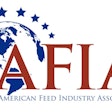
A report by the United States Department of Agriculture (USDA) titledTransportation of U.S. Grains A Modal Share Analysis 1978-2016 Update显示的是美国. moved almost 600 million tons of grain in 2016. With that much grain on the move, the U.S. must maintain and improve the nation’s infrastructure and create fair and transparent regulations for the industry to follow.
On January 6, nearly 50 associations from across agriculture sent a letter to the incoming Biden administration which outlined three primary freight transportation modes — motor, rail and waterborne — and what actions can be taken to improve them for agricultural use. The feed manufacturing, grain handling and grain processing industries rely on the nation’s infrastructure to move products, whether they be bound for domestic or export markets.
Road
The USDA report shows that 61% of U.S. grain movement is done on the nation’s roads and highways through motor carrier transportation or trucking. In 2016, that amounted to almost 350 million tons, 80% of which was bound for domestic locations. These numbers may be why trucking makes up a majority of the association’s letter to the Biden administration. The letter notes exemptions, load-shifting, minimum financial responsibility, the driver shortage and weight limits as areas they would like action taken.
Hours of Service (HOS) rules regulate how many hours a driver can work on consecutive days — typically 60 or 70 hours over eight days. Since 1995, agriculture has been granted certain exceptions because of the seasonal nature of the work. The letter outlines four incremental changes to those exceptions to provide more flexibility to the industry. It recommends:
- Eliminating planting and harvesting periods
- Providing a 150-air-mile exemption from HOS regulations on the backend of truck movements
- Including an Federal Motor Carrier Safety Administration (FMCSA) pilot program for transporters of farm supplies
- Finalizing the FMCSA’s interim rule updating the definition of an agricultural commodity for purposes of determining eligible freight for the agricultural exemption
Because agriculture products tend to shift during transport, current fixed axle weight limits on trailers force many to underload trailers or risk getting ticked on the road even if their total loads are under the weight limit. The letter asks for a 10% load-shift axle tolerance for trucks transporting cargo in trailers specifically designed to hold dry bulk goods to fix this oversight.
The letter also urges the administration not to raise the current $750,000 minimum financial responsibility requirement for motor carriers, arguing that raising the minimum would “cause even greater targeting of truckers and increase the cost burden for trucking and lead to the introduction of higher truck freight rates and fewer for-hire motor carriers, with no demonstrable improvement in motor carrier safety.”
忠贞ral-level commercial driving license (CDL) restrictions on drivers aged 18 to 20 create an obstacle in recruiting new drivers. Federal law does not allow 18- to 20-year-old CDL holders to drive on interstates or cross state lines. The letter supports a proposed FMCSA pilot project to allow drivers 18 to 20 years old to operate commercial motor vehicles in interstate commerce that contains many concepts from the DRIVE SAFE Act to increase safety.
The 49 associations also request the administration harmonize federal interstate weight regulations with the weight limits adopted by states. The Coronavirus Aid Relief and Economic Security Act gave states the ability to increase and harmonize truck weight limits for state and Interstate Highways within their jurisdiction. This power expires 120 days following a presidential disaster declaration. The letter requests the ability of states to set and harmonize weight limits permanently.
Rail
“Transportation of U.S. Grains A Modal Share Analysis 1978-2016 Update” ranks rail as the second most popular mode of freight transportation for U.S. grain. The rail system in the U.S. moved more than 140 million tons in 2016 for 25% of the grain transportation market share.
Rail is vital for grain markets, both domestic and export. Much of the rail section of the letter to the Biden administration focuses on the consolidation in the rail market.
The letter notes 90% of rail traffic in the U.S. is handled by just four railroads and that in many locations, agriculture facilities have only one option for rail freight. The associations note they believe railroads have a right to make enough revenue to reinvest in their product and make a reasonable profit. Due to consolidation, however, railroads have an unfair advantage when dictating terms to customers.
To help fix this imbalance, the associations suggest the Surface Transportation Board (STB) update and eliminate many of its regulations and policies that were implemented decades ago by the STB and its predecessor, the Interstate Commerce Commission, that are no longer relevant in today’s rail marketplace.
A 2015 study conducted by the National Academy of Sciences’ Transportation Research Board came up with suggestions of policies and rules that need to be reviewed and actions that need to be taken. These include:
- The need to instill more rail-to-rail competition
- Define the meaning of railroad’s legal common carrier obligation “to provide service upon reasonable request”
- Implement meaningful rail rate reform
- Review current commodity exemptions from the STB regulation, including those for particular forest and paper products
The letter states, “It is critical that the STB provide meaningful regulatory oversight and serve as a neutral body to adjudicate rail marketplace disputes.
“Continuing efforts to modernize this critical agency under the Biden administration will help farmers, agribusinesses and manufacturers be more viable and competitive while still preserving a vibrant and profitable rail industry.”
水
The remaining 14%, more than 81 million tons, of grain that moved through the U.S. was moved across the nation’s waterways in 2016. Almost all of the grain moved this way was destined for export markets, with 48% of exported grain being transported this way.
The letter to the Biden administration notes shipping on U.S. waterways is the safest and most environmentally responsible way to send products to market. A towboat pushing 15 barges of dry cargo moves as much as 1,050 semi-trucks or six locomotives pulling 216 rail cars.
The letter urges the administration to invest in infrastructure projects and policies for the waterways, including:
- Modernizing outdated locks and dams on the Upper Mississippi and Illinois River System
- Enacting WRDA bills every two years to ensure important policy updates are made promptly
- Continuing the Federal Maritime Commission’s (FMC) investigation of detention and demurrage, export container availability and container return practices of ocean carriers
If the Biden administration addresses the concerns laid out in the letter, the U.S. will continue to have the safest, most efficient and reliable agriculture supply chain in the world. ■

.jpg?auto=format%2Ccompress&crop=faces&fit=crop&h=48&q=70&w=48)




















